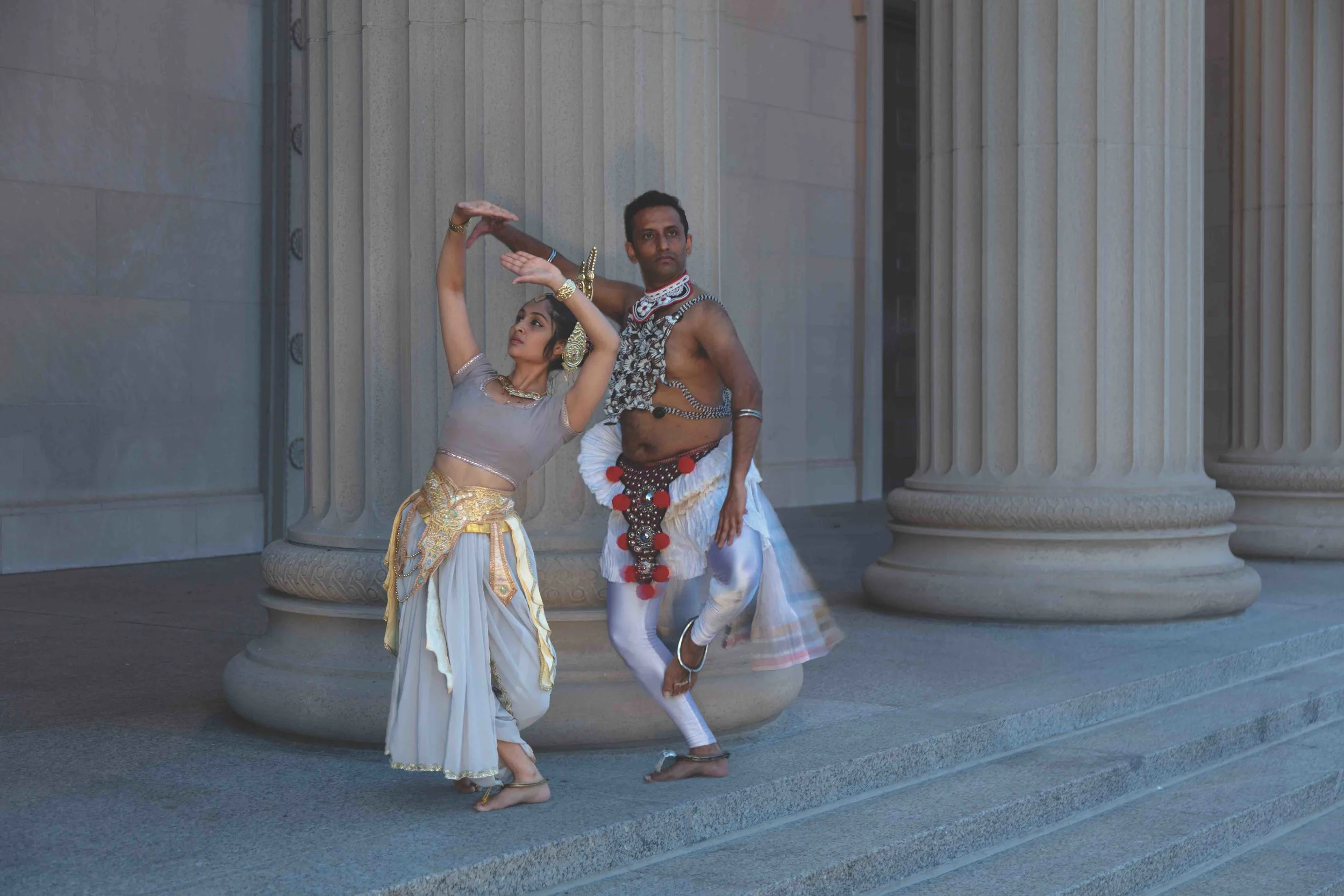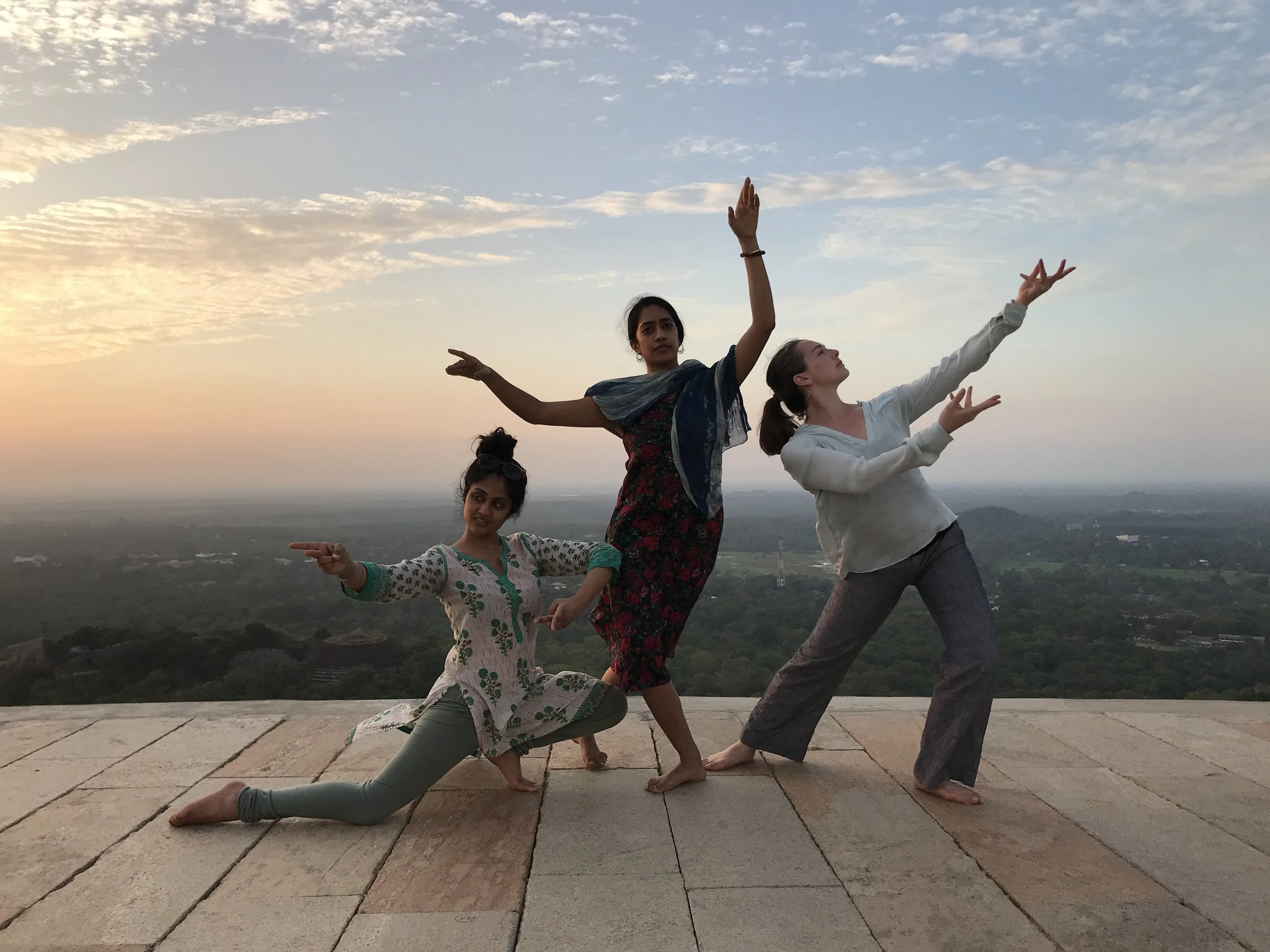Of Masks & Myths: A Dance Journey 125 Years in the Making
Masks & Myths promo image.
By Suzanne Carmel
On October 6 and 7, 2018, the Mandala South Asian Arts Ensemble, accompanied by Sri Lankan artists, will celebrate the culmination of a year-long cultural exchange with the performance Masks and Myths: Devils and Dancers at the Logan Center. Dance and music will depict the traditions of Sri Lankan performance, the effects of colonialism on artistry, and how contemporary Sri Lankan dance has evolved both in spite of and in response to colonialism, expressing the power and bravery necessary to keep art forms alive.
Focusing on Sri Lankan dance is of special significance this year as Chicago celebrates the 125th anniversary of the World’s Columbian Exposition—or Chicago World’s Fair— which first brought Sri Lankan culture to the city from the country that, at that time, was called Ceylon. Flash forward to 2017, when Sri Lankan native Sudesh Mantillake was in Chicago to perform and lead a master class at the Logan Center. While passing through Midway Plaisance–site of this first encounter with a Chicago audience–he was deeply moved, inspiring this modern-day, contrasting performance, where Mantillake and the ensemble are free to express and make their own art.
Masks and Myths is a piece in three parts. It begins in 1893, with a Sinhalese artist visiting the fairgrounds where other cultural dance forms can be seen. In the second work, he visits Sri Lanka, a culture deeply rooted in history but also undergoing extraordinarily rapid change. The artist reminisces about the dance forms in Sri Lanka. The third work is a response to the history and current state of Sri Lankan artistry, reflecting on and honoring global arts and Chicago perspectives. Dance artists trained in various forms will explore global themes through contemporary movement inspired by Sri Lankan dance.
While visitors to the 1893 World’s Fair could experience the lushly appointed Ceylon Building and adjacent tea room, and view a collection of indigenous arts and products, such as spices, the pavilion told a story of Ceylon as filtered through the country’s European colonizers. The Ceylon Building— commissioned by Queen Victoria, designed by British architect H.F. Tomlin, and constructed by 53 Sri Lankan natives—was meant to reflect the architecture and ornamentation native to the island. The natives brought to Chicago to serve tea, perform dances, and pose for photographs were little more than set dressing. Little to no effort was made by the Ceylon Building’s British owners to explain to visitors the nature or cultural significance of the Sri Lankan rituals, wardrobes, or performances presented. Without this much needed context for engaging with a foreign culture, visitors ultimately used the term “Devil Dancers” to describe the performers, because they wore elaborate masks and danced in a “frenzy.”
“I hope that after seeing Masks and Myths the audience will look at performance from Sri Lanka and other former colonized countries differently,” says Mantillake. “I believe that in Masks and Myths, we, as Sri Lankans, have an agency to represent what we want to express to the audience about our country and its performances.”
Mandala Executive Artistic Director Pranita (Jain) Nayar is in large part responsible for making this performance a reality. Nayar has spent more than twenty years bringing the music and dance of South Asia, ranging from Persia to Indonesia, to western audiences. A resident of Chicago since 1990, the Indian immigrant formed Mandala three years ago, with a mission to promote cultural awareness and exchange through arts and education, led by a broad range of local and visiting dancers, musicians, teaching artists, collaborators, and outreach partners. Ensemble performances range from classical to contemporary, frequently subjecting traditional forms to innovative treatment and thereby creating contemporary pieces that blend dance styles and cultures.
“I think we as immigrants cling to our traditions a bit more than our counterparts in India, who see art as constantly evolving,” says Ashwaty Chennat, Mandala’s lead choreographer/dancer. “We are more hesitant to see it evolve, and I think Pranita is a pioneer in changing some of those perspectives here, so it’s
exciting to work with her for that reason.”
Mandala Sri Lanka visit. Photo: Connor Torres.
As part of the year-long cultural exchange with Sri Lanka, funded by the MacArthur Foundation, four members of the ensemble, including Chennat, traveled to Sri Lanka in February 2018 for ten days. During the trip, they learned about Sri Lankan culture and dance, and shared Nayar’s contemporary style of “Unwinding” Bharatanatyam— a deconstructed form of India’s highly ornamental, classical dance form—as well as a ballet workshop with local students. The ensemble was also able to study with renowned masters, learning drumming from Chinthaka Bandara and movement from Vajira Mantillake and Shantha Tennakoon.
“Sri Lankan dance doesn’t really have a large platform in Chicago, let alone outside of the country,” says Chennat. “It’s something that is so rooted in its context and its way of life in Sri Lanka. All children there somehow engage with Sri Lankan dance. It’s everywhere, and it’s very important to its communities.”
Mantillake added that his native country’s dance doesn’t exist in a vacuum. “It is a living culture that interacts with everyday lives of people. You cannot fully grasp it by only studying the movements but must examine singing, drumming, mask-making, temple paintings, and rituals–all components of Sri Lankan dance culture.”
Nayar first traveled to Sri Lanka in 2008 to see Kandyan dance in Colombo, the capital city, and returned in 2009. Given her contrasting background in Bharatanatyam, she was drawn to the raw, earthy form of Kandyan dance, based in indigenous ritual dancing and powerful footwork, leaps, and whirls. An expert in understanding how traditions evolve over time, the diasporic artist strives to change perspectives, striking a balance between traditional dance and a continually evolving artform.
“Ceylon (colonized by the British from 1848 until 1972), was considered the brightest jewel in the Queen’s crown,” says Nayar. “While in land mass Sri Lanka is very small, the richness of its culture and the hospitality of its people continue to make it a very attractive place. Art forms change when another culture is imposed on a native one, or due to internal strife. What happened in Sri Lanka is similar to what happens in other places in the world.”
Mandala aims to look at the situation both from this point of view and another perspective as well. Nayar recalls that many colonized nations were represented at the 1893 World’s Fair and it was Chicago’s first exposure to many parts of Asia and Europe, as well as those countries’ first exposure to Chicago. Many opinions and judgments were formulated as a result of the World’s Fair. The contradiction at the very heart of the event was familiar: on the one hand, the negative effects of colonialism and putting foreigners on display for the amusement of others; and on the other hand, the benefits of expanding horizons for the native artists and the local audiences.
“How do we move forward from the experience of colonialism, and how it manifested at the Fair?” asks Nayar. “Chicago has changed, the world has changed, and Chicago has changed the world.”
Clashes between Sinhala and Tamil cultures within Sri Lanka have compounded the effects of colonization. The traditions of both cultures are represented in native dances, yet their dances are distinct and the effects of colonial and nationalist histories can be seen in recent artworks.
“This is why it’s important to study dance history,” says Mantillake. “By examining dance history under pre-colonial, colonial, and postcolonial conditions, we can trace alternative histories that have been erased by colonial and nationalist histories.”
According to Nayar, Sri Lanka is still deeply rooted in its own traditions, but there is a younger population that wants to explore and move forward.
The challenge that Mantillake faces is a familiar one for artists keen to nurture tradition and innovate at the same time. “The strong bond between the dancer and the ground is also unique in Sri Lankan dance,” says Mantillake. “Although it has changed, I still see the groundedness of the dancer playing a major role. Finding the balance between preserving the tradition and creation is tricky. Through my research, I have found that adaptability, while keeping its energy is one of the salient features of Sri Lankan dance. Therefore, to me, working with artists who practice different movement patterns is an enriching experience.”
“We feel very fortunate that we have a large vocabulary of South Asian and Southeast Asian dance and music forms, which we can deconstruct and use to create something really exciting,” says Nayar. “We are not lacking in material, so it is a very energetic group of artists, very motivated to create modernity out of the traditional South Asian. We are walking on the edge with being the pioneers, but somebody has to do it.”
“In order to break a structure and move out of it, you have to know the music and dance deeply,” says Nayar. “All of the artists are extremely well trained in classical forms. These are very thoughtful innovations, where we have the cultural consultants in from the parent countries to guide us (in this case, Mantillake). It’s a matter of great pride for the underrepresented communities in Chicago, whether it’s Sri Lanka or Indonesia. They are really small communities, but it’s a matter of great importance and, for Chicago itself, it makes for a more vibrant canvas of what the city represents.”
Though this is the first cultural exchange for Mandala, Nayar has done two such exchanges in the past with India, also funded by the MacArthur Foundation. She hopes to do more in the future and to continue work with the respective consulates and with Indonesia and Thailand.
Mandala consistently offers programming featuring global artists and does outreach with the Chicago Park District and public libraries. The small, not-for-profit organization is supported in part by the MacArthur Foundation, the Chicago Community Trust, and the Field Foundation.
“I hope Chicagoans come out and see the work and the relevance of the work,” says Nayar. “Change has to begin at the grassroots.”


